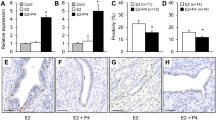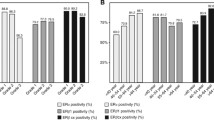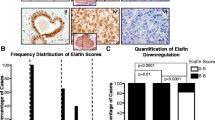Abstract
Background: Many studies have addressed the effect of the timing of surgery for breast cancer relative to menstrual cycle phase, with conflicting results. Explanations for the possibility that survival could be altered by the appropriate timing of breast cancer surgery in humans remain speculative.
Methods: We examined the expression of three estrogen related proteins (c-erbB-2, cathepsin D, pS2) in the breast tumors from 69 premenopausal women sampled in different phases of the menstrual cycle. Data on S-phase fraction and hormone receptor expression were also analyzed. Immunohistochemical assays were used to measure the proteins of interest. S-phase fraction was determined by flow cytometry. Analyses were performed based on fraction of cells staining positive for the protein, density of stain, and a histoscore that combined both fraction of positive cells and density.
Results: We found no differences in c-erbB-2, cathepsin D, hormone receptor, or S-phase levels in tumors sampled in the follicular versus luteal phase, or perimenstrual versus periovulatory phase. The exception was pS2, which was expressed at greater levels during the luteal than during the follicular phase of the cycle (p<0.01); but there was no difference in pS2 expression when the patients were classified as periovulatory versus perimenstrual.
Conclusions: Our findings do not support a variation in c-erbB-2, cathepsin D, S-phase fraction, or receptor expression as an explanation for the differences in breast cancer prognosis when surgery is timed by menstrual cycle phase. The finding that pS2 (an indicator of hormone sensitivity, and possibly better prognosis) is expressed at higher levels in tumor samples during the luteal phase suggests that the biologic profile of breast tumors may vary with the menstrual cycle and that these variations deserve further study.
Similar content being viewed by others
References
Saad Z, Bramwell V, Duff J, et al. Timing of surgery in relation to the menstrual cycle in premenopausal women with operable breast cancer.Br J Surg 1994;81:217–20.
Veronesi U, Luini A, Mariani L, et al. Effect of menstrual phase on surgical treatment of breast cancer.Lancet 1994;343:1545–7.
Holli K, Isola J, Hakama M. Prognostic effect of timing of operation in relation to menstrual phase of breast cancer patient—fact or fallacy.Br J Cancer 1995;71:124–7.
Spratt JS, Zirnheld J, Yancey JM. Breast cancer detection demonstration project data can determine whether the prognosis of breast cancer is affected by the time of surgery during the menstrual cycle.J Surg Oncol 1993;53:4–9.
Senie RT, Kinne DW. Menstrual timing of treatment for breast cancer.Monogr Natl Cancer Inst 1994;16:85–90.
Badwe RA, Gregory WM, Chaudary MA, et al. Timing of surgery during menstrual cycle and survival of premenopausal women with operable breast cancer.Lancet 1991;337:1261–4.
Bluming A, Hrushesky WJM. The effect of surgical timing within the fertility cycle on breast cancer outcome.Ann N Y Acad Sci 1991;618:277–91.
Corder AP, Cross M, Julious SA, Mullee MA, Taylor I. The timing of breast cancer surgery within the menstrual cycle.Postgrad Med J 1994;70:281–4.
Kroman N, Hojgaard A, Andersen KW, et al. Timing of surgery in relation to menstrual cycle does not predict the prognosis in primary breast cancer.Eur J Surg Oncol 1994;20:430–5.
Gnant MFX, Seifert M, Jakesz R, Adler A, Mittlboeck M, Sevelda P. Breast cancer and timing of surgery during menstrual cycle. A 5-year analysis of 385 pre-menopausal women.Int J Cancer 1992;52:707–12.
Powles TJ, Jones AL, Ashley S, Tidy A. Menstrual effect on surgical cure of breast cancer.Lancet 1989;1343–4.
Rageth JC, Wyss P, Unger C, Hochuli E. Timing of breast cancer surgery within the menstrual cycle: influence on lymph-node involvement, receptor status, postoperative metastatic spread and local recurrence.Ann Oncol 1991;2:269–72.
Donegan WL, Shah D. Prognosis of patients with breast cancer related to the timing of operation.Arch Surg 1993;128:309–13.
Gelber RD, Goldhirsch A. Menstrual effect on surgical cure of breast cancer.Lancet 1989;2:1344.
Nathan B, Bates T, Anbazhagan R, Norman AR. Timing of surgery for breast cancer in relation to the menstrual cycle and survival of premenopausal women.Br J Surg 1993;80:43.
Anonymous. Systemic treatment of early breast cancer by hormonal, cytotoxic, or immune therapy. 133 randomized trials involving 31,000 recurrences and 24,000 deaths among 75,000 women. Early Breast Cancer Trialists' Collaborative Group.Lancet 1992;339:1–15.
Anonymous. Systemic treatment of early breast cancer by hormonal, cytotoxic, or immune therapy. 133 randomized trials involving 31,000 recurrences and 24,000 deaths among 75,000 women. Early Breast Cancer Trialists' Collaborative Group.Lancet 1992;339:71–85.
Foekens JA, Rio MC, Seguin P, et al. Prediction of relapse and survival in breast cancer patients by pS2 protein status.Cancer Res 1990;50:3832–7.
Tandon AK, Clark GM, Chamness GC, Chirgwin JM, McGuire WL. Cathepsin D and prognosis in breast cancer.N Engl J Med 1990;322:297–302.
Granata G, Coradini D, Cappalletti V, DiFronzo G. Prognostic relevance of cathepsin D versus estrogen receptors in node negative breast cancers.Eur J Cancer 1991;27:970–2.
Gullick WJ, Love SB, Wright C, et al. c-erbB-2 protein overexpression in breast cancer is a risk factor in patients with involved and uninvolved lymph nodes.Br J Cancer 1991;63:434–8.
Patterson MC, Dietrich KD, Danyluk J, et al. Correlation between c-erbB-2 amplification and risk of recurrent disease in node-negative breast cancer.Cancer Res 1991;51:556–67.
Borg A, Tandon AK, Sigurdsson H, et al. HER-2/neu amplification predicts poor survival in node-positive breast cancer.Cancer Res 1990;50:4332–7.
Dati C, Antoniotti S, Taverna D, Perroteau I, DeBortoli M. Inhibition of c-erb B-2 oncogene expression by estrogens in human breast cancer cells.Oncogene 1990;5:1001–6.
DeBortoli M, Dati C, Antoniotti S, Maggiora P, Sapei ML. Hormonal regulation of c-erbB-2 oncogene expression in breast cancer cells.J Steroid Biochem Mol Biol 1992;43:21–5.
Clark GM, Dressler LG, Owens MA, et al. Prediction of relapse or survival in patients with node-negative breast cancer by DNA flow cytometry.N Engl J Med 1989;320:627–33.
Hedley DW, Rugg CA, Gelber RD. Association of DNA index and S-phase fraction with prognosis of node positive early breast cancer.Cancer Res 1987;47:4729–35.
Witzig T, Loprinzi C, Gonchoroff N, et al. Cell kinetic measurements as predictors of recurrence and survival in stages B2 and C colorectal adenocarcinoma.Cancer 1991;68:879–88.
Markopoulos C, Berger U, Wilson P, Gazet JC, Coombes RC. Oestrogen receptor content of normal breast cells and breast carcinomas throughout the menstrual cycle.Br Med J 1988;296:1349–51.
Racca S, Conti G, Pietribiasi F, et al. Correlation between pS2 protein positivity, steroid receptor status and other prognostic factors in breast cancer.Int J Biol Markers 1995;10:87–93.
Soubeyran I, Wafflart J, Bonichon F, et al. Immunohistochemical determination of pS2 in invasive breast carcinomas: a study on 942 cases.Breast Cancer Res Treat 1995;34:119–28.
Schwartz LH, Koerner FC, Edgerton SM, et al. pS2 expression and response to hormonal therapy in patients with advanced breast cancer.Cancer Res 1992;52:624–8.
el-Tanani MK, Green CD. Oestrogen-induced genes, pLIV-1 and pS2, respond divergently to other steroid hormones in MCF-7 cells.Mol Cell Endocrinol 1995;111:75–81.
Thim L. A new family of growth factor-like peptides: trefoil disulphide loop structures as a common feature in breast cancer associated peptid (pS2), pancreatic spasmolytic polypeptide (PSP) and frog skin peptides (spasmolysins).FEBS Lett 1989;250:85–90.
Nunez AM, Jakowleb S, Briand JP, Gaire M, Krust A, Rio MC, Chambon P. Characterization of the estrogen-induced pS2 protein secreted by the human breast cancer cell line MCF-7*.Endocrinology 1987;121:1759–65.
Rio MC, Bellocq JP, Daniel JY, et al. Breast cancer-associated pS2 protein: synthesis and secretion by normal stomach mucosa.Science 1988;241:705–8.
Seitz G, Thelsinger B, Tomasetto G, Rio MC, Chambon P, Blin N, Welter G. Breast cancer associated-protein pS2 expression in tumors of the biliary tract.Am J Gastroenterol 1991;86:1491–4.
Hanby AM, Jankowski JA, Elia G, Poulsom R, Wright NA. Expression of the trefoil peptides PS2 and human spasmolytic polypeptide (hSP) in Barrett's metaplasia and the native oesophageal epithelium: delineation of epithelial phenotype.J Pathol 1994;173:213–9.
Oliver DJ, Ingram DM. Timing of surgery during the menstrual cycle for breast cancer: possible role of growth factors [Abstract].Eur J Cancer 1995;31:325–8.
Saad Z, Vincent M, Bramwell V, et al. Timing of surgery influences survival in receptor-negative as well as receptor-positive breast cancer [Abstract].Eur J Cancer 1994;30:1348–52.
Fentiman IS, Gregory WM. The hormonal milieu and prognosis in operable breast cancer.Cancer Surv 1993;18:149–63.
Hrushesky WJM, Gruber SA, Sothern RB, et al. Natural killer cell activity: age, estrous-and circadian-stage dependence and inverse correlation with metastatic potential.J Natl Cancer Inst 1988;80:1232–7.
Hanna N, Schneider M. Enhancement of tumor metastasis and suppression of natural killer cell activity by B-estradiol treatment.J Immunol 1983;130:974–80.
Ferguson JE, Schor AM, Howell A, Ferguson MWJ. Changes in the extracellular matrix of the normal human breast during menstrual cycle.Cell Tissue Res 1992;268:167–77.
van den Brule FA, Engel J, Stetler-Stevenson WG, Liu FT, Sobel ME, Castronovo V. Genes involved in tumor invasion and metastasis are differentially modulated by estradiol and progestin in human breast-cancer cells.Int J Cancer 1992;52:653–7.
Sauerbrei W, Bastert G, Schmoor C. Prognostic effect of timing of surgery during menstrual cycle in premenopausal breast-cancer patients.Int J Cancer 1994;59:149–50.
Author information
Authors and Affiliations
Rights and permissions
About this article
Cite this article
Khan, S.A., Gonchoroff, N.J. & Miller, L.E. Expression of pS2, c-erbB-2, and cathepsin D during the menstrual cycle in human breast cancers. Annals of Surgical Oncology 4, 462–469 (1997). https://doi.org/10.1007/BF02303669
Received:
Accepted:
Issue Date:
DOI: https://doi.org/10.1007/BF02303669




